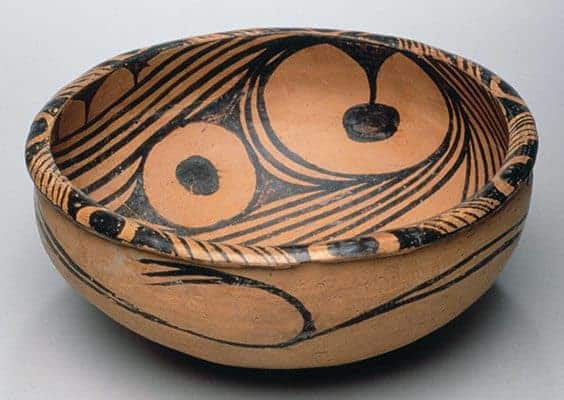8000 BC – 500 AD
Neolithic Eras began after the end of the last Ice Age, and vary across cultures. The art of these distinct periods is comprised of the arts of people that had progressed from hunter-gatherers to permanent settlers, mainly living in farming communities.
The majority of the art produced by Neolithic artists is functional in nature and used in their daily lives, such as pottery or terracotta representations of deity that would have been found in the home.
There are other greater and larger pieces like the megaliths, shrines, tombs, and rock carvings. There are also smaller items like jewelry.
Art History: Neolithic Art Origins and Historical Importance:
The dates for the Neolithic period and its artwork vary by location and culture, but it typically begins when the animals thrust out of the North during the last Ice Age began to return to their home environments.
This change caused people to give up their hunter-gatherer lifestyles in favor of the stability of agriculture. When this happened varied greatly by location and climate. Because they were stable rather than mobile, they had more time to devote to refining the crafts of the Stone Age. Stone tools were now crafted, polished, and more refined, rather than being mere chipped rocks.
“Stonehenge was a place of burial from its beginning to its zenith in the mid-third millennium B.C. The cremation burial dating to Stonehenge’s sarsen stones phase is likely just one of many from this later period of the monument’s use and demonstrates that it was still very much a domain of the dead”. — Mike Parker Pearson
With the advent of agriculture and likewise stability, mortality rates dropped and the population expanded.
Agriculture also brought with it a need to protect the boundaries of territory and this led to both opposition with neighboring communities or with the alliance to them.
When alliances between small communities felt the need to protect themselves from mutual enemies, they came together to form cities. Religion became developed into defined beliefs with structures rather than myriads of personal gods.
A social hierarchy developed and primitive governmental ideas were formed.

The “New Stone Age” as the era is also called, also brought with it more intellectual thought and advancement.
The megaliths created are thought by scholars to have purposes other than worship. Many of these structures follow the sun or moon in a way that suggests they are calendars, and the megalith at Knowth in England is drawn with lunar maps. The Pyramids at Giza are the subject of much scholarly theory that includes ideas of solar timing or astrology.
Of course, megaliths were also places of worship, and in addition to these, Neolithic peoples also created shrines and temples to their gods. The temples of Malta, for instance, 50 Neolithic religious temples have been found and from what archeologists can determine, they were once richly decorated with curtains, statues, and other ornamentation.
“In the 40,000 year time scale we’re all the same people. We’re all equally primitive, give or take two or three thousand years here or a hundred years there.” ― Gary Snyder
Rock art was present in megaliths, shrines, and tombs, but also in caves and in the open outdoors in some places.
While rock art had been present in previous eras, in the Neolithic it began to include symbols and pictographs that eventually would lead to writing. In Australian art, the geometric forms alone are symbols of very complex and extensive ideas that are understood by Aborigines even in singular instances, such a simple spiral.
Pottery in the Neolithic era is an extensive subject that can be divided by many groups within many groups; however, some common characteristics are seen throughout the world. The dates for a culture’s adoption of pottery often define it’s a progression into the Neolithic category, with the exception of the Far East where pottery predates agriculture.
Pottery during the Neolithic era is mostly in terracotta or clay and many cultures, despite their separation by continents and oceans, decorated these pieces with simple geometric designs and then later broke into shaping them to resemble animals or other objects.

Terracotta was also used in sculpture. Subjects of sculpture were often seated deities or small figures. Other forms of decorative art emerged as people began to want to embellish their homes. Murals, statuettes, and ornamentation for both the home and the body appeared. Textiles became more patterned and of higher quality. Jade carving became popular in China and in the Late Neolithic period, artists were at the very dawn of working in gold and other precious metals.
“Generally speaking, color directly influences the soul. Color is the keyboard, the eyes are the hammers, the soul is the piano with many strings. The artist is the hand that plays, touching one key or another purposively, to cause vibrations in the soul”. — Wassily Kandinsky
Neolithic Art Key Highlights:
- Archeologists and anthropologists have found that while tooth wear went into decline after the advent of pottery, tooth decay increased. They surmise that this is because with pottery, grains could be boiled and the mushy consistency of porridges led to tooth decay.
- The potter’s the wheel was invented in Mesopotamia in the Ubaid period. This invention greatly expanded imagination and possibilities for the sculptor and potter.
- Several archeological sites of the Neolithic period have been named UNESCO World Heritage sites and are conserved by this arm of the United Nations through funding.
Neolithic Art Top Works:
- Catal Huyak
- Stonehenge
- Newgrange site
- Knowth
- Mehrgarh, Pakistan
- Nevali Cori
- Thinker of Cernavoda – National Museum of Romania
- Altimira Mural
- Petroglyphs of Cammuni
- Temple of Gigantija – Island of Gozo, Malta
[html_block id=”9712″]
[html_block id=”9474″]

